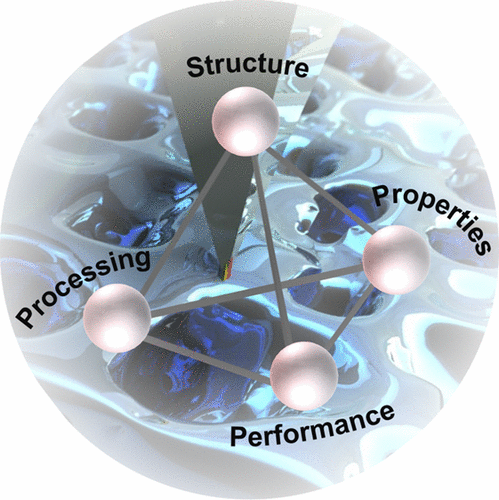MSE Research Group’s Invited Perspective Published in ACS Energy Letters

The materials science tetrahedron (pyramid-shape) atop an image of a solar cell being probed at the nanoscale. Functional imaging characterization bonds the structural properties together, completing the tetrahedron.
|
The need for renewable energy is increasing significantly every year. By 2020, the world will require an estimated 184,000 TWh (terawatt hours) of power annually, and solar power is the only renewable energy source capable of meeting this need. That said, efficient and low-cost photovoltaic (PV) technology, i.e., equipment that converts sunlight into electricity, is still just beyond our reach.
To that end, researchers in the Materials Science and Engineering (MSE) department and the Institute for Research in Electronics and Applied Physics (IREAP) at the University of Maryland (UMD) - Elizabeth Tennyson (5th year graduate student), John Howard (3rd year graduate student) and Marina Leite (Asst Professor) – were invited by the editor of ACS Energy Letters to offer a perspective on what we can expect from solar energy and related technology in the coming decade.
Their Perspective discusses which materials might be the most capable of harnessing solar energy, cheaply and efficiently, with particular emphasis on perovskites and polycrystalline materials, i.e., CdTe (cadmium telluride), CIGS (Copper, indium, gallium and selenium; a semiconductor material), CZTS (Copper zinc tin sulfide; another semiconducting compound) and polycrystalline GaAs.
Currently, perovskites – a material that mimics the structure of calcium titanium oxide – are of great interest in the scientific community. Indeed, Leite’s group published another research paper earlier this year discussing the possibilities of hybrid organic-inorganic perovskites, based on methylammonium lead. This unique material, if properly harnessed, could provide the most efficient and cost effective solution to solar cell mechanisms; however, it’s incredibly sensitive to heat and humidity, and thus, is too volatile to be utilized at this time.
The Perspective continues with a discussion on the necessity of mesoscale, or nanoscale, functional imaging (i.e., super high resolution of solar cells) as a means of better understanding either how the localized electrical signal behaves, or how perovskites are effected by variables such as heat, light, and humidity, which requires high speed mapping methods. In a nutshell, high tech equipment is vital for the study of perovskite degradation – if the equipment isn’t fast enough, or close enough, the change could easily be missed.
“The macroscopic performance of non-uniform PV devices strongly depends on their mesoscale constructs, where the behavior of the average density of atoms corresponding to length scales of 5-50 nm is more relevant than the contribution of the individual atoms themselves,” Leite’s group stated in the paper.
Leite’s Perspective also discusses the importance of data analytics in studying solar cells. “Machine learning approaches based on big data analytics will likely help scientists determine which defects and grain boundaries in polycrystalline PV materials contribute the most to performance deficiencies,” the group reported. In other words, the study of solar cell energy requires very large storage files, in addition to specialized programs and algorithms, to help sift through and analyze all of the data.
This research was published in ACS Energy Letters in July 2017. For additional information:
Tennyson, E. M., Howard, J. M., & Leite, M. S. (2017, July 7). Mesoscale Functional Imaging of Materials for Photovoltaics. ACS Energy Letters, 2(8), 1825-1834. doi: 10.1021/acsenergylett.7b00382
Related Media:
Sunbeams at the Nanoscale: the Next Generation of Solar Cells – UMD/MSE, March 2017
The Warhol Batteries – UMD/MSE, December 2015
New efficiencies in solar cells on the horizon - IREAP/UMD, September 2015
August 27, 2017
Prev
Next |
|












